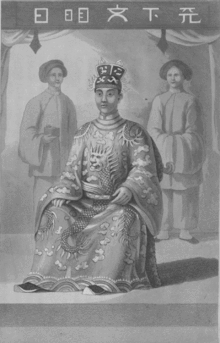Minh Mạng
| Minh Mạng | |||||||||||||||||
|---|---|---|---|---|---|---|---|---|---|---|---|---|---|---|---|---|---|
| Emperor of Đại Nam | |||||||||||||||||

Portrait of Emperor Minh Mang
|
|||||||||||||||||
| Reign | 14 February 1820 – 20 January 1841 | ||||||||||||||||
| Predecessor | Gia Long | ||||||||||||||||
| Successor | Thiệu Trị | ||||||||||||||||
| Born | 25 May 1791 Gia Định, Đại Nam |
||||||||||||||||
| Died | 20 January 1841 (aged 49) Phú Xuân, Đại Nam |
||||||||||||||||
| Burial | Hiếu Lăng | ||||||||||||||||
| Spouse | Empress Tá Thiên | ||||||||||||||||
| Issue |
Nguyễn Phúc Miên Tông, Emperor Thiệu Trị 77 other sons and 64 daughters |
||||||||||||||||
|
|||||||||||||||||
| House | Nguyễn dynasty | ||||||||||||||||
| Father | Emperor Gia Long | ||||||||||||||||
| Mother | Empress Thuận Thiên | ||||||||||||||||
| Religion | Confucianism | ||||||||||||||||
| Signature |  |
||||||||||||||||
| Full name | |
|---|---|
| Nguyễn Phúc Đảm (阮福膽) Nguyễn Phúc Kiểu (阮福晈) |
|
| Era name and dates | |
| Minh Mạng: 1821–1840 | |
| Posthumous name | |
| Thể Thiên Xương Vận Chí Hiếu Thuần Đức Văn Vũ Minh Đoạn Sang Thuật Đại Thành Hậu Trạch Phong Công Nhân Hoàng đế 體天昌運至孝淳德文武明斷創述大成厚宅豐功仁皇帝 |
|
| Temple name | |
| Thánh Tổ (聖祖) |
| Minh Mạng | |
| Vietnamese name | |
|---|---|
| Vietnamese | Minh Mạng |
| Hán-Nôm | |
| Birth name |
Minh Mạng (25 May 1791 – 20 January 1841; born Nguyễn Phúc Đảm, also known as Nguyễn Phúc Kiểu) was the second emperor of the Nguyễn dynasty of Vietnam, reigning from 14 February 1820 until his death, on 20 January 1841. He was the fourth son of Emperor Gia Long, whose eldest son, Crown Prince Cảnh, had died in 1801. He was well known for his opposition to French involvement in Vietnam and his rigid Confucian orthodoxy.
Born Nguyễn Phúc Đảm at Gia Định in the middle of the Second Tây Sơn - Nguyễn Civil War, Minh Mạng was the fourth son of lord Nguyễn Phúc Ánh - future Emperor Gia Long. His mother was Gia Long’s second wife Trần Thị Đang (historically known as Empress Thuận Thiên). At the age of three, under the effect of a written agreement made by Gia Long with his first wife Tống Thị Lan (Empress Thừa Thiên), he was taken in and raised by the lord consort as her own son.
Following Thừa Thiên’s death in 1814, it was supposed that her grandson, Crown Prince Cảnh’s eldest son Mỹ Đường, would be responsible for conducting the funeral. Gia Long however, brought out the agreement to insist that Phúc Đảm, as Thừa Thiên’s son, should be the one fulfilling the duty. Despite opposition from mandarins such as Nguyễn Văn Thành, Gia Long was decisive with his selection.
In 1816, Gia Long appointed Đảm as his heir apparent. After the ceremony, Crown Prince Đảm moved to Thanh Hòa Palace and started assisting his father in processing documents and discussing country issues.
Gia Long's death coincided with the re-establishment of the Paris Missionary Society's operations in Vietnam, which had closed in 1792 during the chaos of the power struggle between Gia Long and the Tây Sơn brothers before Vietnam was unified. In the early years of Minh Mạng's government, the most serious challenge came from one of his father's most trusted lieutenants and a national hero in Vietnam, Lê Văn Duyệt, who had led the Nguyễn forces to victory at Qui Nhơn in 1801 against the Tây Sơn Dynasty and was made regent in the south by Gia Long with full freedom to rule and deal with foreign powers.
...
Wikipedia
